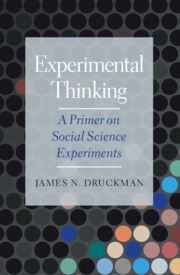Book contents
- Experimental Thinking
- Experimental Thinking
- Copyright page
- Dedication
- Contents
- Figures
- Tables
- Preface
- Acknowledgments
- 1 Why a Primer on Social Science Experiments?
- 2 The Scientific Process and How to Think about Experiments
- 3 Evaluating Experiments
- 4 Innovations in Experimental Designs
- 5 What to Do before, during, and after an Experiment
- 6 Designing “Good” Experiments
- References
- Index
4 - Innovations in Experimental Designs
Opportunities and Limitations
Published online by Cambridge University Press: 12 May 2022
- Experimental Thinking
- Experimental Thinking
- Copyright page
- Dedication
- Contents
- Figures
- Tables
- Preface
- Acknowledgments
- 1 Why a Primer on Social Science Experiments?
- 2 The Scientific Process and How to Think about Experiments
- 3 Evaluating Experiments
- 4 Innovations in Experimental Designs
- 5 What to Do before, during, and after an Experiment
- 6 Designing “Good” Experiments
- References
- Index
Summary
Chapter 4 turns to experimental designs, focusing on three designs that have gained prominence in many social science applications in the last decade: audit field experiments, conjoint survey experiments, and lab-in-the-field experiments. These three designs also provide readers with examples of a type of field experiment, survey experiment, and lab experiment, respectively – the three conventional “types” of experiments employed in the social sciences. The chapter reviews the basics of each design and provides prominent examples. Importantly, it also discusses limitations and challenges of the designs, or put another way, how to think about these new designs. This chapter includes a brief overview of “public policy experiments”: It does so given the recent rise in studies of political elites, which ultimately connect to policymaking and responsiveness. The chapter makes clear that the substantive questions being explored should drive experimental design choices and not vice versa.
- Type
- Chapter
- Information
- Experimental ThinkingA Primer on Social Science Experiments, pp. 85 - 116Publisher: Cambridge University PressPrint publication year: 2022



